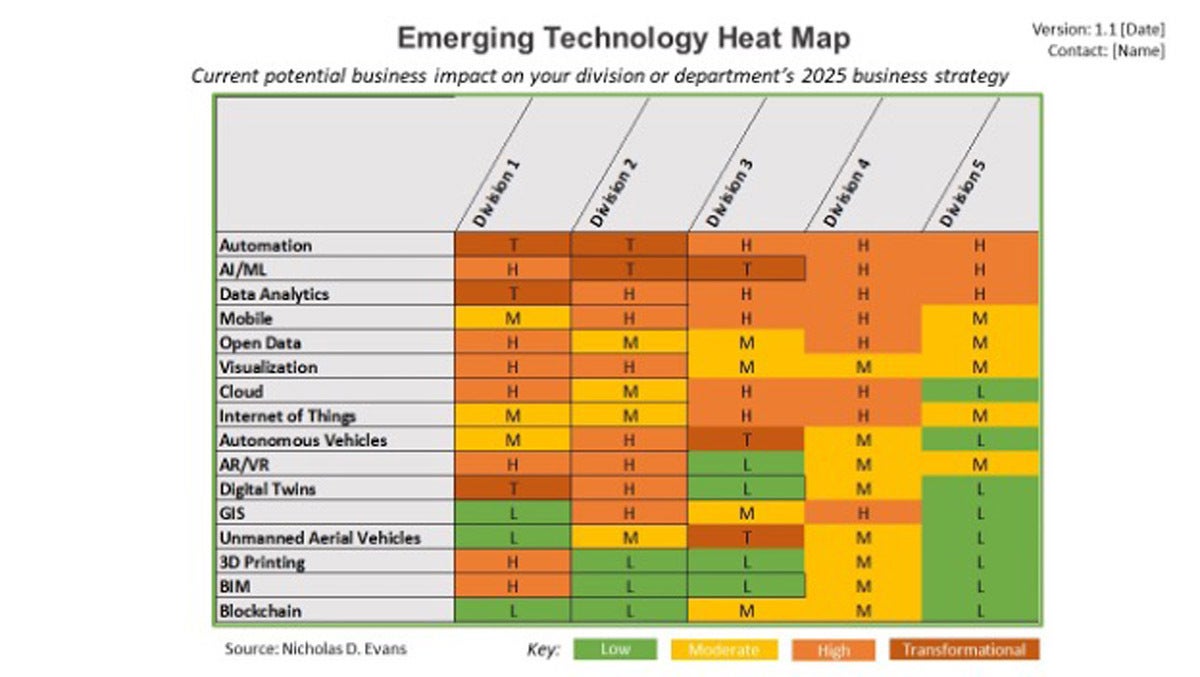How To Create A Geographical Heat Map
By , Contributing writer, CIO |
How (and why) to create an emerging technology heat map
Use this rapid assessment tool to uncover the emerging technologies and trends that are of strategic importance to the business.
![Network World: IoT Hacks [slide-08] > Hot in Here > IoT-connected thermostat systems](https://images.idgesg.net/images/article/2018/06/nw_ss_strange_and_scary_iot_hacks_slide_08_thermostat_by_moja_msanii_cc0_via_unsplash_network_connections_red_sparks_hot_heat_fire_fireworks_sparklers_by_thomas_vogel_getty_images_1200x800-100762620-large.jpg?auto=webp&quality=85,70)
An emerging technology heat map can be a valuable tool to illuminate the various emerging and disruptive technologies on your organization's radar. When sourced internally across your organization's various divisions and departments, it can serve as a rapid assessment tool to help reveal and set priorities as well as areas for further collaboration and coordination.
The heat map can help uncover synergies across divisions and departments where you might be able to leverage investments, projects, resources and/or tools. It's also important to explore the differences. These may reveal where one group has discovered an opportunity that might work for others or perhaps a niche area or use case only applicable to a single division or department. Either way, the heat map will quicky reveal these similarities and differences and help to further these important discussions. The target audience for these discussions can be division leads themselves, in order to play back the cross-divisional findings, as well as the C-suite to share and capture feedback on these firm-wide priorities.
Follow these steps to design, implement, and act on your emerging technology heat map.
Design
Start by creating a template that includes the technologies you wish to evaluate and what you'd like to learn about each of them from your internal stakeholders. A simple heat map might look at the potential business impact of a set of 15-20 emerging and disruptive technologies in terms of low, moderate, high, or transformational impact upon the business.
This template should be further specified so respondents know the exact timeframe for making their assessment, such as today's perceived impact or the perceived impact upon the 2025 strategy looking across the entire time horizon.
For each technology or trend listed, it's also important to provide definitions so that respondents know exactly what is meant by certain terms, such as "digital twins" or "3D printing", but also the intended scope of more common terms such as "cloud computing" or "mobility". In terms of mobility, for example, the scope when considering potential business impact might include devices, applications, and infrastructure as a whole.
Next, design how you'd like the data collection template as well as the end product to look visually so that you can confirm it will yield the desired information and insight for your target audience. Even basic office tools such as spreadsheets can work well for data collection and the key is to make the template easy to complete while still yielding the desired level of detail from respondents.
Implement
Once your template has been designed and you have finalized the exact information you're after from your divisions and departments, you can send out your request with a due date for responses. Give respondents plenty of time as well as flexibility to decide how to collect their data whether it's an individual response from a division leader or a collective effort from their team. It's important to give an example of how to fill out the form, but this can be a fictitious example so as not to "lead the witness" by sharing other divisions' responses.
A simple approach might be to phrase the request like this: "Please enter Low, Moderate, High or Transformational for each technology or trend to denote their current potential business impact on your division or department's 2025 business strategy."
As the results start to come in, you can populate an integrated view as shown in the figure below. For an added level of detail, you can also ask for their envisioned use cases for each technology or trend.
 Nicholas D. Evans
Nicholas D. Evans Analyze and act
To maximize the potential of your emerging technology heat map, it is important not to use it as an end unto itself, but as a conversation starter. Share the completed, integrated heat map with all participants and even consider sharing via the company intranet. (Since the information is likely to be company confidential, be sure to provide guidance not to share it outside the company.) Use the information strategically and embed it into your strategic plans to help illustrate the technologies and trends that are of strategic importance to the business.
This technique can also be integrated into existing strategic planning processes and activities or into your innovation and technology strategy. While the heat map exercise is simple and can be conducted at any time, a best practice is to incorporate it into annual cycles of these broader strategic planning processes and fit it into their timeframes.
Once you've gone through the heat map exercise, capture feedback from participants on the value of the process and how it can be improved. Just like SWOT analysis or other strategic planning tools, the heat map may well become a valuable tool in your toolkit.
Nicholas D. Evans is the Chief Innovation Officer at WGI, a national design and professional services firm. He is the founder of Thinkers360, the world's premier B2B thought leader and influencer marketplace as well as Innovators360.
Copyright © 2021 IDG Communications, Inc.
How To Create A Geographical Heat Map
Source: https://www.cio.com/article/3625876/how-and-why-to-create-an-emerging-technology-heat-map.html
Posted by: richardswhishour.blogspot.com

0 Response to "How To Create A Geographical Heat Map"
Post a Comment